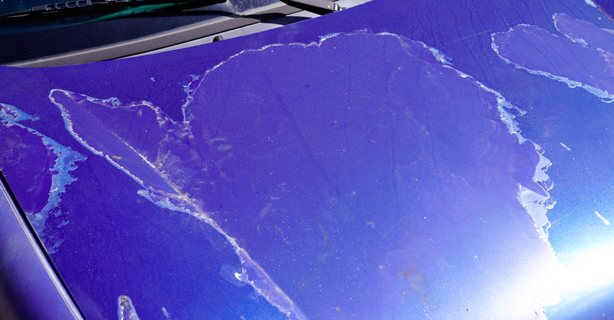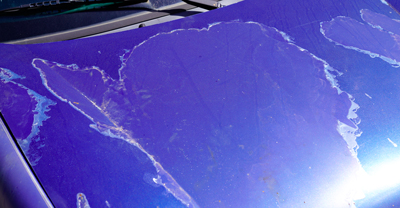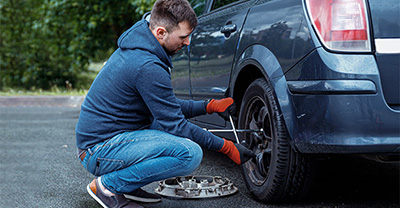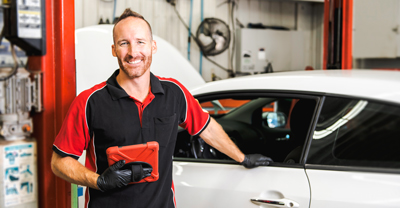How to protect your vehicle against weather damage


0 min. read
Whether your local climate hits record highs or sinks to frigid lows, the weather can have a surprising impact on your vehicle’s performance and condition. You’ve probably heard general warnings throughout your driving career, but what exactly should you be aware of?
Here, we’ll tackle some common questions and equip you with the knowledge to help navigate weather situations, along with some vehicle maintenance tips to help prepare you for all types of weather.
Can a car be too cold to drive?
Frigid temperatures cause your oil to thicken, making it more challenging to start the engine. When the oil's viscosity increases, it affects how well it lubricates the engine. Regular oil changes and proper oil for your region's seasonal temperatures can reduce the severity of this concern.
However, other vital fluids can be affected, too, including wiper fluid, antifreeze, and brake fluid. Keep these fluids topped up to ensure your car is winter-ready—and when available, invest in a winter-blend option. Talk to your mechanic about the best options for the weather conditions in your area.
In car batteries, the chemical reaction that produces energy slows down in the cold, weakening your battery's power. So, while it's actually a myth that the cold "sucks power" out of your battery, it can make your battery less efficient, especially if it's old and weak.
Make sure your car doesn’t freeze in winter
If you’re dealing with consistently low temperatures and your car feels sluggish when you start it up, there are some steps you can take to keep your car warm.
Park inside whenever possible. A closed garage will stay several degrees warmer than the outside air and keep snow off your car.
Test your battery before the cold season and replace it with a new one if necessary.
Purchase an electric block heater to help keep your car’s battery and oil warm.
Use a lower-viscosity oil that’s still suitable for the make and model of your car.
At what temperature does gas freeze?
We’ve all heard that if the gas in your tank is too low on cold winter nights, your gas can freeze and damage your car.
But is that even possible?
The short answer is "Yes." However, for most types of gasoline, temperatures need to drop to between -40 and -200 degrees Fahrenheit, with most molecules freezing at -100 degrees. Even then, gas doesn't completely freeze like water—but it can coagulate and become syrupy.
If you only have a small amount of gas in your tank, you leave much more room above that fuel level for air. If that air is warmer than your gas tank walls, condensation will form—just like you might see on your windows during winter.
Ice crystals can then get into your fuel line, causing the gas to flow slowly or block up completely, which will cause your car to sputter.
Winter gas tank maintenance
The best solution to frozen gas lines is prevention.
As much as possible, keep your gas tank full throughout the cold months. Limiting the air in the tank lessens the chance for condensation to form. A common practice is to keep your tank above 1/3 full in the winter.
You can also add a bottle of gas line antifreeze or fuel conditioner to your tank when you fill up. You can safely do this every time you fill up, or you can keep a bottle on hand and add it only when it’s going to be especially cold, or you feel your car start to sputter.
If your fuel lines freeze, the best way to fix it is to warm up the car and then treat the fuel with one of the above additives.

Get a free car insurance quote today.
What temperature is too hot for cars?
Summer temperatures impact how well your car operates, forcing many parts to work much harder than in milder conditions. Some of the most affected parts are car batteries, tires, and engines.
Effects of high temperatures on your car battery
Excessive heat can cause water in a battery's electrolyte fluid to evaporate. This process can weaken the battery’s ability to charge and cause plate corrosion—resulting in shorter battery life and unreliable starting.
How tires react to high temperatures
When temperatures rise, the air inside your tires expands. Overinflated tires:
Wear unevenly
are at a higher risk of blowout
have significantly reduced traction.
Tires are also more vulnerable to wear and tear on hot pavement, which can cause new damage or worsen existing flaws.
Heat damage to car engines
Your car’s engine works harder in almost every way when exposed to extreme heat. The fluids that keep the engine lubricated can start to evaporate and the cooling system may burn more coolant and circulate inefficiently.
High-temperature car maintenance
Knowing how to combat heat exposure is essential for driving in the summer heat.
Park in the shade whenever possible
Keep the battery posts clean and drive regularly to keep the battery charged
Check your tire pressure regularly and remove air if necessary to maintain the factory-recommended level
Inspect tires for signs of damage and replace damaged or balding tires
Keep an eye on your coolant levels and top off before long drives
How do I protect my car paint from weather?
When your car is exposed to the sun's rays for extended periods, the paint job can degrade, causing it to fade, bubble, crack, chip, or peel. You may notice this happening more quickly if you park your car outside year-round.
The sun isn’t the only element working against your paintjob. Rain can leave corrosive pollutants on your car. You can see it in the “rain spots” on your car after a storm.
Snow is also not as clean as it seems. It carries the same pollutants as rain and can stick to your car for longer periods of time. The extended exposure to cold when your car is covered in snow can also cause the paint to contract and crack.
Snow and slush picked up from the road are also full of salt and de-icing chemicals that can corrode paint and cause rust. Salt, in fact, is one of the worst things for your car’s exterior. And it’s not just road salt; ocean salt can have a similar impact. Car owners along the coasts should also keep an eye out for signs of corrosion.
Tips to protect your car paint from weather
The biggest thing you can do to preserve your paintjob and prevent car rust from salt is wash your car on a regular basis. Even when you know it’s going to immediately get dirty again, scrubbing away the layer of dirt, bugs, pollutants, and salt reduces buildup and lasting damage.
You can further protect your car by applying a wax finish after washing. Depending on the type of wax and how much protection you need, this could be annually, or a couple times a year. To protect your car paint from sun damage, park in a sheltered or shaded area whenever possible.
Between washings, keep your car as clear as possible. Promptly remove snow, leaves, or other seasonal debris from the roof and hood. Prolonged exposure can trap moisture and initiate rust.
Can driving in floodwater damage my engine?
Avoid driving in heavy rain whenever possible, as conditions can quickly become hazardous. Flash flooding can wash out roads or cover streets with silty or otherwise contaminated water.
Always avoid standing water while you’re driving—including large puddles. Even if you think you know how deep an area of standing water is, you can’t know for sure. If water enters the engine through the air intake or exhaust, the engine can hydrolock or seize. This happens when the pistons try to compress water in the cylinder and the built-up pressure escapes in a catastrophic way, cracking the cylinder or bending the rods.
Breakdowns also increase during periods of wet weather, especially among older vehicles. Even a small amount of water in the wrong place can negatively affect your engine or—increasingly in newer cars—your electrical systems.
If you find yourself suddenly in deep water, don’t stop and don’t back up. Both will end with your engine flooded and you stranded.
Learn more about protecting your vehicle
Protecting your vehicle begins with understanding risks, weather-related or otherwise, and regular maintenance. To learn more ways weather affects your vehicle and associated maintenance tips, visit our Resource Center.
The general information in this blog is for informational or entertainment purposes only. View our blog disclaimer.
*Data accuracy is subject to this article's publication date.










